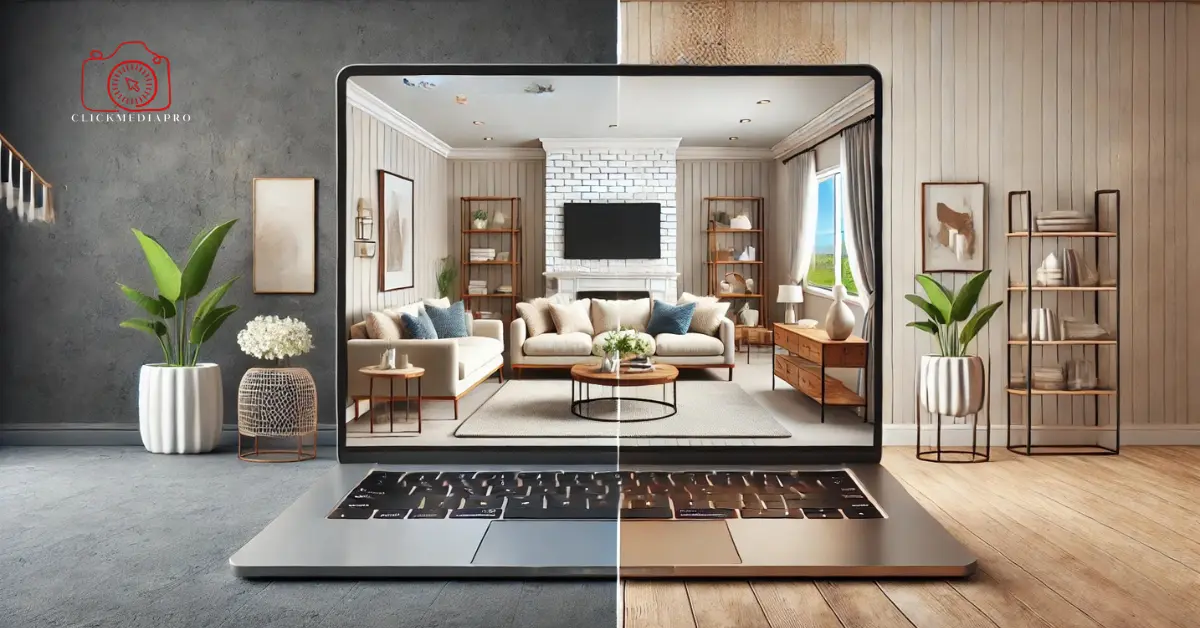Virtual Staging vs Traditional Staging – In today’s highly competitive real estate market, staging has become a crucial component of selling homes quickly and at higher prices. A well-staged home can enhance its appeal, helping potential buyers envision themselves living in the space. Traditionally, home staging involved physically furnishing and decorating a property to make it more attractive to buyers. However, with advancements in technology, virtual staging has emerged as a popular alternative, offering a digital way to stage homes at a fraction of the cost.
The question many sellers, agents, and developers now face is: Which option is better—virtual staging or traditional staging? Both methods have their advantages and drawbacks, making it essential to understand their impact on real estate marketing.
This comprehensive guide explores the differences between virtual and traditional staging, analyzing their pros and cons to help you determine the best solution for your real estate listings.
Table of Contents
ToggleWhat is Traditional Home Staging?
Traditional home staging involves physically furnishing and decorating a property to create an inviting atmosphere that resonates with potential buyers. Professional home stagers use furniture, artwork, and accessories to highlight a property’s best features and make it feel more appealing.
How Traditional Staging Works
- A professional stager visits the property and develops a staging plan.
- Furniture, décor, and accessories are rented and arranged to enhance the home’s appeal.
- The staging setup remains throughout the selling period or until the home is sold.
Discover the latest preconstruction homes in Markham, Ontario and explore exclusive opportunities to secure your dream home at unbeatable prices.
Pros of Traditional Staging
- Tangible Experience: Buyers can physically walk through the staged home, experiencing the layout and ambiance in person.
- Emotional Connection: Seeing a beautifully furnished home can create an emotional bond with potential buyers.
- Professional Appeal: Traditional staging adds a high-end, curated look that can justify a higher asking price.
- Realistic Visualization: It allows buyers to see the true scale and potential of each room without relying on imagination.
- Ideal for Luxury Listings: High-end properties often benefit from traditional staging to complement their luxurious features.
Stay updated with expert insights and news on preconstruction projects in Ontario by visiting this comprehensive blog.
Cons of Traditional Staging
- High Costs: Renting furniture and hiring staging professionals can be expensive, with costs ranging from $2,000 to $10,000 or more depending on the property size.
- Logistical Challenges: Coordinating furniture deliveries, installations, and removals can be time-consuming and labor-intensive.
- Limited Flexibility: Once staged, changes are difficult to implement without additional costs.
- Wear and Tear: Staged properties may suffer from wear and tear during open houses and showings.
Browse the most recent Markham real estate listings to find your perfect property in this thriving Ontario community.
What is Virtual Staging?
Virtual staging involves digitally enhancing property photos by adding furniture, décor, and other design elements using advanced software. Virtual staging allows agents and sellers to present fully furnished rooms without physically moving a single item into the space.
Explore market trends and tips for buying or selling property in Markham by visiting the ultimate Markham real estate blog.
How Virtual Staging Works
- A professional photographer captures high-quality images of an empty or minimally furnished home.
- Virtual staging software or designers digitally add furniture, artwork, and decor to the images.
- The staged photos are used in online listings, brochures, and marketing materials.
Enhance your property listings with stunning visuals by partnering with real estate photography experts in Markham at Click Media Pro.
Pros of Virtual Staging
- Cost-Effective: Virtual staging costs significantly less than traditional staging, typically ranging from $50 to $300 per image.
- Quick Turnaround: Digital staging can be completed in as little as 24–48 hours, speeding up the listing process.
- Versatility: Allows multiple design styles to appeal to different buyer demographics without physically altering the space.
- Customization Options: Furniture and décor can be tailored to match current market trends or buyer preferences.
- No Physical Labor: No need for moving heavy furniture or coordinating deliveries.
- Ideal for Remote Buyers: Digital images allow out-of-town buyers to visualize the home’s potential without visiting in person.
Cons of Virtual Staging
- Lack of Real-World Experience: Buyers might be disappointed when they visit an empty home that looked furnished online.
- Risk of Misrepresentation: Over-editing or unrealistic staging can mislead buyers, leading to potential dissatisfaction.
- Dependence on High-Quality Photography: Poor-quality photos can negatively impact virtual staging results.
- Limited Emotional Appeal: Without physical furnishings, it may be harder for buyers to form an emotional connection.
Cost Comparison: Virtual Staging vs. Traditional Staging
| Aspect | Traditional Staging | Virtual Staging |
|---|---|---|
| Cost | $2,000 – $10,000+ per home | $50 – $300 per image |
| Time | Several days to weeks | 24 to 48 hours |
| Customization | Limited, costly changes | Easy, multiple style options |
| Buyer Experience | In-person | Online visualization |
| Maintenance | Requires upkeep | No maintenance needed |
For budget-conscious sellers, virtual staging is a clear winner, while sellers looking for maximum impact in competitive markets may still prefer traditional staging despite the higher costs.
When to Choose Traditional Staging
Traditional staging is the preferred choice when:
- The property is in a high-end luxury market where buyers expect a premium presentation.
- The home is vacant and requires a tangible experience for buyers to connect emotionally.
- The target buyers are local and prefer in-person visits.
- The home has unique architectural features that benefit from in-person viewing with furnishings.
Ideal for: Luxury homes, model homes, upscale urban properties, and fully vacant homes.
When to Choose Virtual Staging
Virtual staging is a better fit when:
- Budget constraints make traditional staging impractical.
- The property is being marketed primarily online to a wider audience, including out-of-town buyers.
- The home is occupied and rearranging furniture isn’t feasible.
- The seller wants to showcase different design styles without committing to one.
Ideal for: Budget-friendly listings, rental properties, investor-owned homes, and fast-selling markets.
Best Practices for Virtual and Traditional Staging
Best Practices for Virtual Staging
- Use high-quality, realistic images to avoid misrepresentation.
- Disclose that images are virtually staged to maintain transparency.
- Choose designs that match the style of the home to attract the right buyers.
- Avoid over-staging or adding unrealistic elements.
Best Practices for Traditional Staging
- Work with professional stagers who understand market trends.
- Focus on neutral colors and minimal décor to appeal to a broad audience.
- Keep the property clean and well-maintained to complement the staging.
- Consider seasonal décor adjustments to enhance visual appeal.
Conclusion: Virtual Staging vs Traditional Staging
Both virtual and traditional staging have their advantages and are effective under different circumstances. Virtual staging is an excellent cost-effective option for online marketing, while traditional staging offers a tangible experience that can create emotional connections.
Ultimately, the decision should be based on factors such as budget, target market, and property type. Real estate agents and sellers can even consider a hybrid approach, combining both methods to maximize their marketing efforts.
By understanding the differences and strategic applications of virtual and traditional staging, real estate professionals can make informed decisions that enhance property appeal and drive faster sales.

